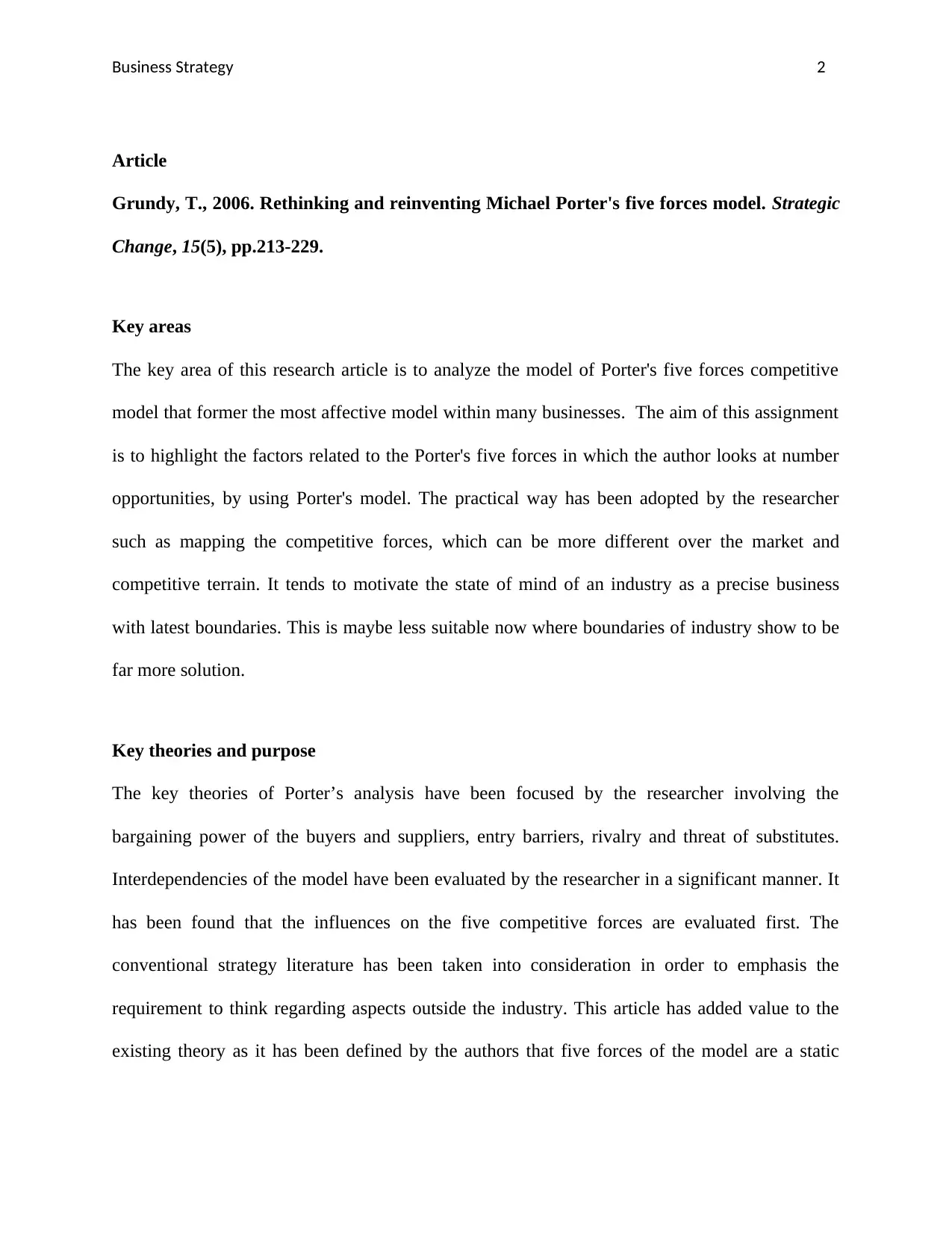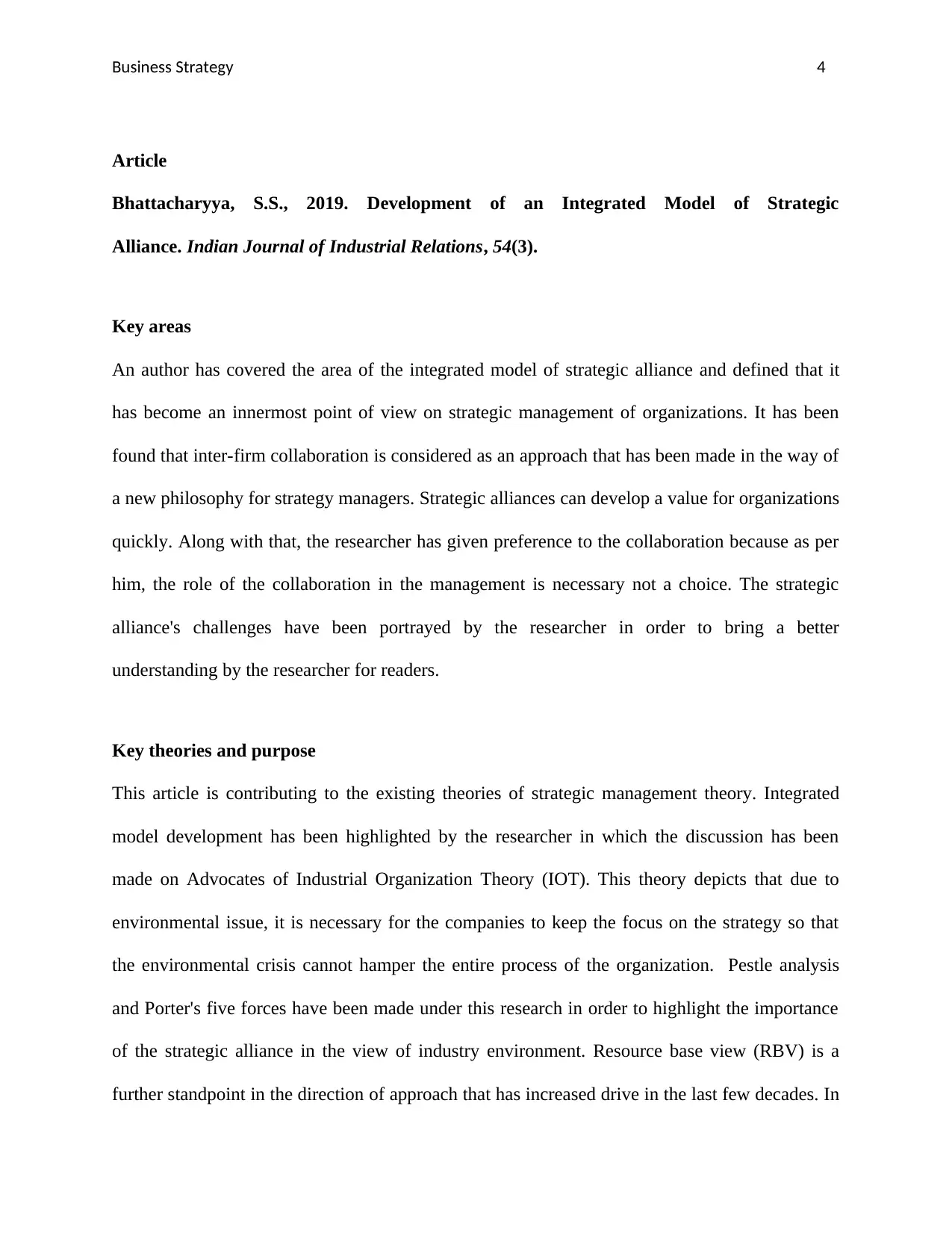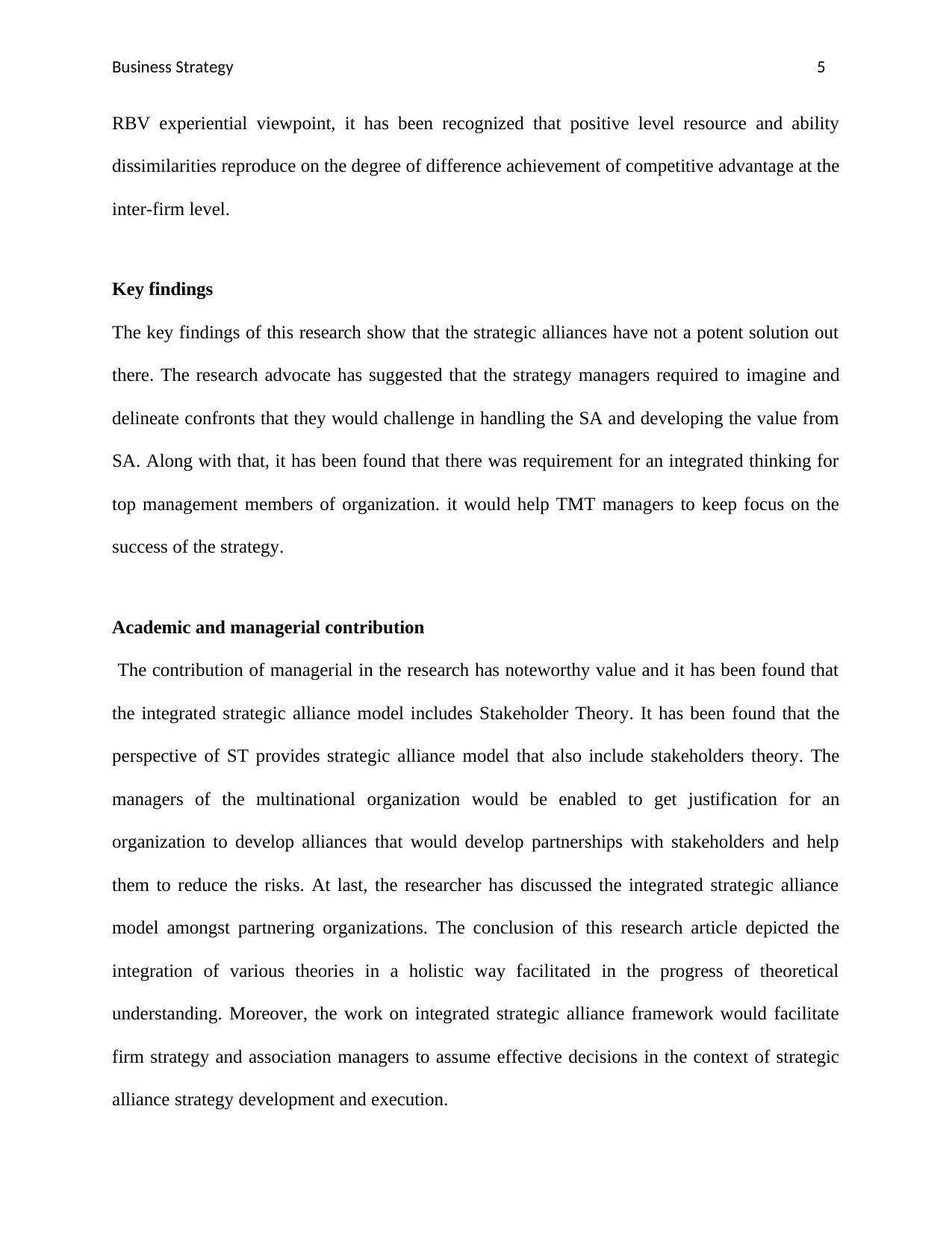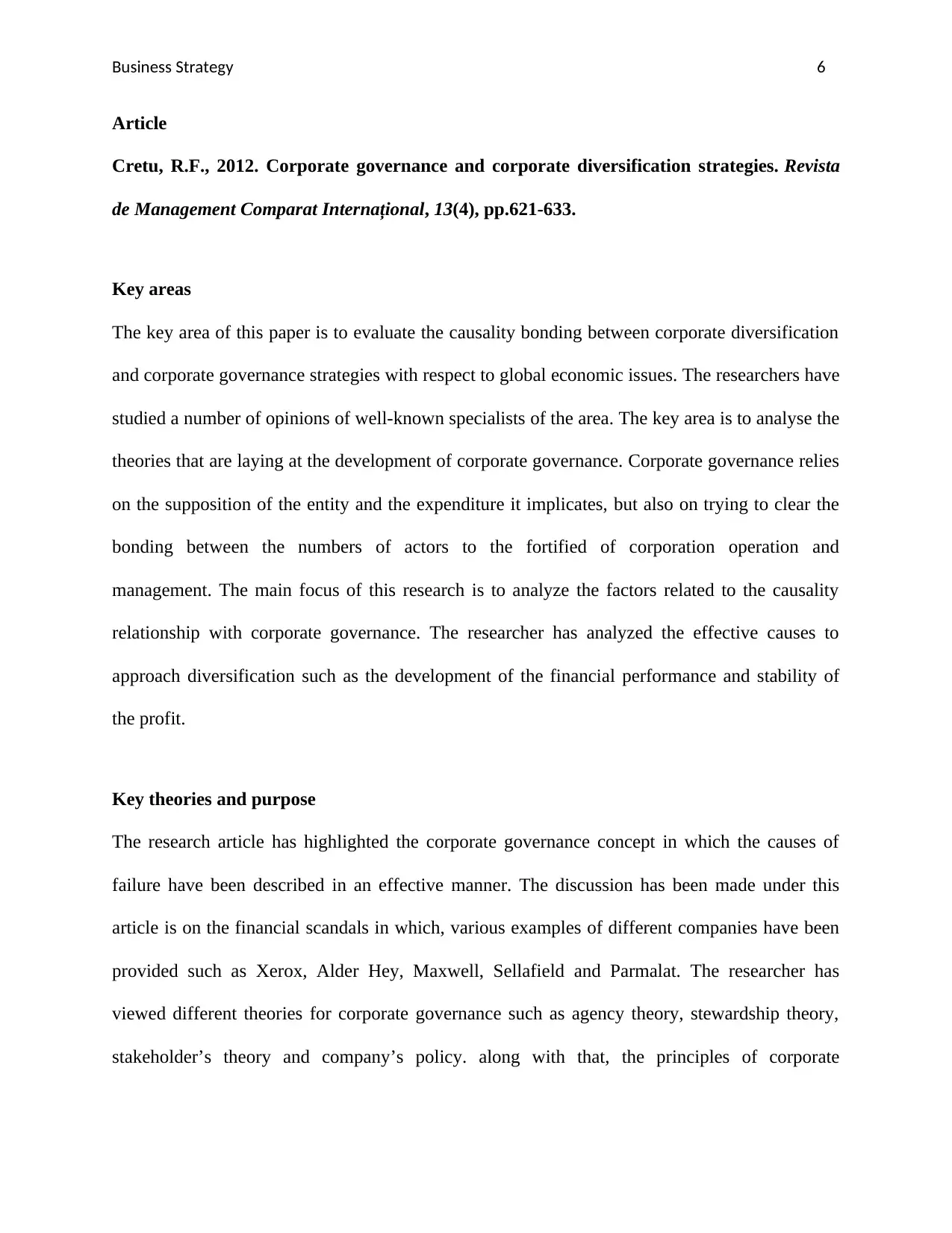Business Strategy Analysis: Corporate Governance and Diversification
VerifiedAdded on 2022/12/23
|8
|1674
|88
Report
AI Summary
This report provides an analysis of several articles related to business strategy. The first article examines Michael Porter's Five Forces model, highlighting its key areas, theories, findings, and contributions to academic and managerial practices. The second article focuses on developing an integrated model of strategic alliances, emphasizing the importance of inter-firm collaboration and the challenges faced by strategy managers, with contributions from Resource Based View and Stakeholder Theory. The third article evaluates the relationship between corporate governance and corporate diversification strategies, analyzing the causality between them in the context of global economic issues, including factors such as financial performance, risk mitigation, and managerial skills. The report provides insights into how these strategic concepts contribute to organizational success and competitive advantage. Furthermore, it discusses the role of corporate culture in SHRM and its impact on firm performance.

Business Strategy 1
Business Strategy
Business Strategy
Paraphrase This Document
Need a fresh take? Get an instant paraphrase of this document with our AI Paraphraser

Business Strategy 2
Article
Grundy, T., 2006. Rethinking and reinventing Michael Porter's five forces model. Strategic
Change, 15(5), pp.213-229.
Key areas
The key area of this research article is to analyze the model of Porter's five forces competitive
model that former the most affective model within many businesses. The aim of this assignment
is to highlight the factors related to the Porter's five forces in which the author looks at number
opportunities, by using Porter's model. The practical way has been adopted by the researcher
such as mapping the competitive forces, which can be more different over the market and
competitive terrain. It tends to motivate the state of mind of an industry as a precise business
with latest boundaries. This is maybe less suitable now where boundaries of industry show to be
far more solution.
Key theories and purpose
The key theories of Porter’s analysis have been focused by the researcher involving the
bargaining power of the buyers and suppliers, entry barriers, rivalry and threat of substitutes.
Interdependencies of the model have been evaluated by the researcher in a significant manner. It
has been found that the influences on the five competitive forces are evaluated first. The
conventional strategy literature has been taken into consideration in order to emphasis the
requirement to think regarding aspects outside the industry. This article has added value to the
existing theory as it has been defined by the authors that five forces of the model are a static
Article
Grundy, T., 2006. Rethinking and reinventing Michael Porter's five forces model. Strategic
Change, 15(5), pp.213-229.
Key areas
The key area of this research article is to analyze the model of Porter's five forces competitive
model that former the most affective model within many businesses. The aim of this assignment
is to highlight the factors related to the Porter's five forces in which the author looks at number
opportunities, by using Porter's model. The practical way has been adopted by the researcher
such as mapping the competitive forces, which can be more different over the market and
competitive terrain. It tends to motivate the state of mind of an industry as a precise business
with latest boundaries. This is maybe less suitable now where boundaries of industry show to be
far more solution.
Key theories and purpose
The key theories of Porter’s analysis have been focused by the researcher involving the
bargaining power of the buyers and suppliers, entry barriers, rivalry and threat of substitutes.
Interdependencies of the model have been evaluated by the researcher in a significant manner. It
has been found that the influences on the five competitive forces are evaluated first. The
conventional strategy literature has been taken into consideration in order to emphasis the
requirement to think regarding aspects outside the industry. This article has added value to the
existing theory as it has been defined by the authors that five forces of the model are a static

Business Strategy 3
model. It is useful in providing sights of dynamic and quite easily. It has been found that the
competitive dynamics can be focused on micro as well as macro level.
Key findings
The key findings of this article depicted that competitive dynamics can be identified at both
micro and macro level. In the context of macro level, it can be seen influencing animatedly over
the industry cycle, for instance, the bargaining power of the buyers and entry barriers. It has been
found that the breakdown of the model is helpful in getting enough knowledge regarding the
project level of the role of the individual where there can be bargaining power, substitutes and
rivalry.
Academic and managerial contribution
The managerial contribution in this research shows that the involvement of this document is to
enlarge the model of porter into an effective system of analysis. With the help of this paper, the
managers of the operation can operationalize and ensuing amendments in their practices. This
article is helpful in contributing to the large organization about getting an effective
understanding regarding porter’s five models as a competitive model within the organization. It
has been found that due to the unique composition of the model, it is elaborated as being mostly
regarding the negative strategic features such as power, supplier power, rivalry and substitutes. It
is quite hard to be relevant the attaining method. The use of this model is higher in the case of
high buyer power.
model. It is useful in providing sights of dynamic and quite easily. It has been found that the
competitive dynamics can be focused on micro as well as macro level.
Key findings
The key findings of this article depicted that competitive dynamics can be identified at both
micro and macro level. In the context of macro level, it can be seen influencing animatedly over
the industry cycle, for instance, the bargaining power of the buyers and entry barriers. It has been
found that the breakdown of the model is helpful in getting enough knowledge regarding the
project level of the role of the individual where there can be bargaining power, substitutes and
rivalry.
Academic and managerial contribution
The managerial contribution in this research shows that the involvement of this document is to
enlarge the model of porter into an effective system of analysis. With the help of this paper, the
managers of the operation can operationalize and ensuing amendments in their practices. This
article is helpful in contributing to the large organization about getting an effective
understanding regarding porter’s five models as a competitive model within the organization. It
has been found that due to the unique composition of the model, it is elaborated as being mostly
regarding the negative strategic features such as power, supplier power, rivalry and substitutes. It
is quite hard to be relevant the attaining method. The use of this model is higher in the case of
high buyer power.
⊘ This is a preview!⊘
Do you want full access?
Subscribe today to unlock all pages.

Trusted by 1+ million students worldwide

Business Strategy 4
Article
Bhattacharyya, S.S., 2019. Development of an Integrated Model of Strategic
Alliance. Indian Journal of Industrial Relations, 54(3).
Key areas
An author has covered the area of the integrated model of strategic alliance and defined that it
has become an innermost point of view on strategic management of organizations. It has been
found that inter-firm collaboration is considered as an approach that has been made in the way of
a new philosophy for strategy managers. Strategic alliances can develop a value for organizations
quickly. Along with that, the researcher has given preference to the collaboration because as per
him, the role of the collaboration in the management is necessary not a choice. The strategic
alliance's challenges have been portrayed by the researcher in order to bring a better
understanding by the researcher for readers.
Key theories and purpose
This article is contributing to the existing theories of strategic management theory. Integrated
model development has been highlighted by the researcher in which the discussion has been
made on Advocates of Industrial Organization Theory (IOT). This theory depicts that due to
environmental issue, it is necessary for the companies to keep the focus on the strategy so that
the environmental crisis cannot hamper the entire process of the organization. Pestle analysis
and Porter's five forces have been made under this research in order to highlight the importance
of the strategic alliance in the view of industry environment. Resource base view (RBV) is a
further standpoint in the direction of approach that has increased drive in the last few decades. In
Article
Bhattacharyya, S.S., 2019. Development of an Integrated Model of Strategic
Alliance. Indian Journal of Industrial Relations, 54(3).
Key areas
An author has covered the area of the integrated model of strategic alliance and defined that it
has become an innermost point of view on strategic management of organizations. It has been
found that inter-firm collaboration is considered as an approach that has been made in the way of
a new philosophy for strategy managers. Strategic alliances can develop a value for organizations
quickly. Along with that, the researcher has given preference to the collaboration because as per
him, the role of the collaboration in the management is necessary not a choice. The strategic
alliance's challenges have been portrayed by the researcher in order to bring a better
understanding by the researcher for readers.
Key theories and purpose
This article is contributing to the existing theories of strategic management theory. Integrated
model development has been highlighted by the researcher in which the discussion has been
made on Advocates of Industrial Organization Theory (IOT). This theory depicts that due to
environmental issue, it is necessary for the companies to keep the focus on the strategy so that
the environmental crisis cannot hamper the entire process of the organization. Pestle analysis
and Porter's five forces have been made under this research in order to highlight the importance
of the strategic alliance in the view of industry environment. Resource base view (RBV) is a
further standpoint in the direction of approach that has increased drive in the last few decades. In
Paraphrase This Document
Need a fresh take? Get an instant paraphrase of this document with our AI Paraphraser

Business Strategy 5
RBV experiential viewpoint, it has been recognized that positive level resource and ability
dissimilarities reproduce on the degree of difference achievement of competitive advantage at the
inter-firm level.
Key findings
The key findings of this research show that the strategic alliances have not a potent solution out
there. The research advocate has suggested that the strategy managers required to imagine and
delineate confronts that they would challenge in handling the SA and developing the value from
SA. Along with that, it has been found that there was requirement for an integrated thinking for
top management members of organization. it would help TMT managers to keep focus on the
success of the strategy.
Academic and managerial contribution
The contribution of managerial in the research has noteworthy value and it has been found that
the integrated strategic alliance model includes Stakeholder Theory. It has been found that the
perspective of ST provides strategic alliance model that also include stakeholders theory. The
managers of the multinational organization would be enabled to get justification for an
organization to develop alliances that would develop partnerships with stakeholders and help
them to reduce the risks. At last, the researcher has discussed the integrated strategic alliance
model amongst partnering organizations. The conclusion of this research article depicted the
integration of various theories in a holistic way facilitated in the progress of theoretical
understanding. Moreover, the work on integrated strategic alliance framework would facilitate
firm strategy and association managers to assume effective decisions in the context of strategic
alliance strategy development and execution.
RBV experiential viewpoint, it has been recognized that positive level resource and ability
dissimilarities reproduce on the degree of difference achievement of competitive advantage at the
inter-firm level.
Key findings
The key findings of this research show that the strategic alliances have not a potent solution out
there. The research advocate has suggested that the strategy managers required to imagine and
delineate confronts that they would challenge in handling the SA and developing the value from
SA. Along with that, it has been found that there was requirement for an integrated thinking for
top management members of organization. it would help TMT managers to keep focus on the
success of the strategy.
Academic and managerial contribution
The contribution of managerial in the research has noteworthy value and it has been found that
the integrated strategic alliance model includes Stakeholder Theory. It has been found that the
perspective of ST provides strategic alliance model that also include stakeholders theory. The
managers of the multinational organization would be enabled to get justification for an
organization to develop alliances that would develop partnerships with stakeholders and help
them to reduce the risks. At last, the researcher has discussed the integrated strategic alliance
model amongst partnering organizations. The conclusion of this research article depicted the
integration of various theories in a holistic way facilitated in the progress of theoretical
understanding. Moreover, the work on integrated strategic alliance framework would facilitate
firm strategy and association managers to assume effective decisions in the context of strategic
alliance strategy development and execution.

Business Strategy 6
Article
Cretu, R.F., 2012. Corporate governance and corporate diversification strategies. Revista
de Management Comparat Internațional, 13(4), pp.621-633.
Key areas
The key area of this paper is to evaluate the causality bonding between corporate diversification
and corporate governance strategies with respect to global economic issues. The researchers have
studied a number of opinions of well-known specialists of the area. The key area is to analyse the
theories that are laying at the development of corporate governance. Corporate governance relies
on the supposition of the entity and the expenditure it implicates, but also on trying to clear the
bonding between the numbers of actors to the fortified of corporation operation and
management. The main focus of this research is to analyze the factors related to the causality
relationship with corporate governance. The researcher has analyzed the effective causes to
approach diversification such as the development of the financial performance and stability of
the profit.
Key theories and purpose
The research article has highlighted the corporate governance concept in which the causes of
failure have been described in an effective manner. The discussion has been made under this
article is on the financial scandals in which, various examples of different companies have been
provided such as Xerox, Alder Hey, Maxwell, Sellafield and Parmalat. The researcher has
viewed different theories for corporate governance such as agency theory, stewardship theory,
stakeholder’s theory and company’s policy. along with that, the principles of corporate
Article
Cretu, R.F., 2012. Corporate governance and corporate diversification strategies. Revista
de Management Comparat Internațional, 13(4), pp.621-633.
Key areas
The key area of this paper is to evaluate the causality bonding between corporate diversification
and corporate governance strategies with respect to global economic issues. The researchers have
studied a number of opinions of well-known specialists of the area. The key area is to analyse the
theories that are laying at the development of corporate governance. Corporate governance relies
on the supposition of the entity and the expenditure it implicates, but also on trying to clear the
bonding between the numbers of actors to the fortified of corporation operation and
management. The main focus of this research is to analyze the factors related to the causality
relationship with corporate governance. The researcher has analyzed the effective causes to
approach diversification such as the development of the financial performance and stability of
the profit.
Key theories and purpose
The research article has highlighted the corporate governance concept in which the causes of
failure have been described in an effective manner. The discussion has been made under this
article is on the financial scandals in which, various examples of different companies have been
provided such as Xerox, Alder Hey, Maxwell, Sellafield and Parmalat. The researcher has
viewed different theories for corporate governance such as agency theory, stewardship theory,
stakeholder’s theory and company’s policy. along with that, the principles of corporate
⊘ This is a preview!⊘
Do you want full access?
Subscribe today to unlock all pages.

Trusted by 1+ million students worldwide

Business Strategy 7
governance has been highlighted by the researcher in order to elaborate on the necessity of
corporate governance.
Key findings
The key findings of the research are portrayed that the corporate governance within the company
can decrease the risks and amplify the performance. With the help of effective corporate
governance within the entity can open the way to financial markets and carries competitive
goods and services on the market. The management can be performed in a more productive way
by improving the managerial skills. It shall be noted that the lack of obligatory rules and
frameworks could divert to disorder in business. Along with that, the findings from the research
show the importance of diversification as it helps in mitigating the risks without influence
incomes. The different way from the diversification of the investment portfolios demonstrates
the transfer of the entity to a new segment of activity.
Academic and managerial contribution
The contribution of this study is significant in the large organization in the context of getting
better understanding regarding corporate governance. The managers of the multinational
organization would be benefitted in the context of bringing change in the business for the
increasing potential of the employees. It has been found that corporate governance shows the
passage of the company to new activity purpose with taking consideration of the internal
development process. The author of this article has reviewed many journal articles in order to
provide a better outcome for the proposed topic. In the end, the author has concluded that the
mergers and acquisition can amplify the market share of the entity majorly when both of them
covered similar domain of activity.
governance has been highlighted by the researcher in order to elaborate on the necessity of
corporate governance.
Key findings
The key findings of the research are portrayed that the corporate governance within the company
can decrease the risks and amplify the performance. With the help of effective corporate
governance within the entity can open the way to financial markets and carries competitive
goods and services on the market. The management can be performed in a more productive way
by improving the managerial skills. It shall be noted that the lack of obligatory rules and
frameworks could divert to disorder in business. Along with that, the findings from the research
show the importance of diversification as it helps in mitigating the risks without influence
incomes. The different way from the diversification of the investment portfolios demonstrates
the transfer of the entity to a new segment of activity.
Academic and managerial contribution
The contribution of this study is significant in the large organization in the context of getting
better understanding regarding corporate governance. The managers of the multinational
organization would be benefitted in the context of bringing change in the business for the
increasing potential of the employees. It has been found that corporate governance shows the
passage of the company to new activity purpose with taking consideration of the internal
development process. The author of this article has reviewed many journal articles in order to
provide a better outcome for the proposed topic. In the end, the author has concluded that the
mergers and acquisition can amplify the market share of the entity majorly when both of them
covered similar domain of activity.
Paraphrase This Document
Need a fresh take? Get an instant paraphrase of this document with our AI Paraphraser

Business Strategy 8
1 out of 8
Related Documents
Your All-in-One AI-Powered Toolkit for Academic Success.
+13062052269
info@desklib.com
Available 24*7 on WhatsApp / Email
![[object Object]](/_next/static/media/star-bottom.7253800d.svg)
Unlock your academic potential
Copyright © 2020–2025 A2Z Services. All Rights Reserved. Developed and managed by ZUCOL.





